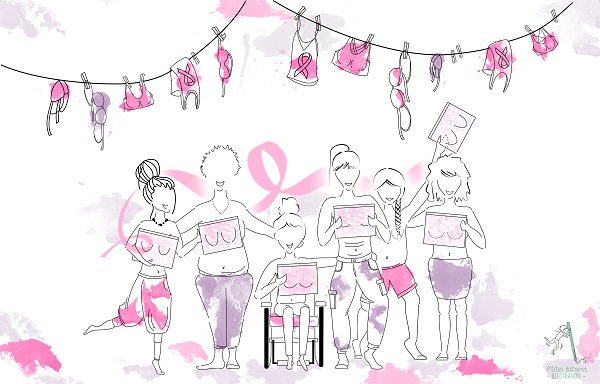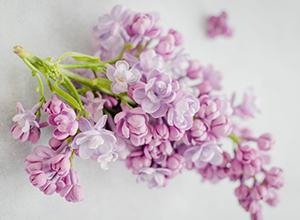Breast Cancer Now celebrates 28 years of the pink ribbon during 'Pinktober'!
Published 8 Oct 2020 • By Candice Salomé
For the 28th consecutive year, "Pinktober", a campaign against breast cancer organised by Breast Cancer Now and other breast cancer organisations worldwide, will take place from 1 to 31 October. Recognisable by its legendary pink ribbon, 'Pinktober', another name for Breast Cancer Awareness Month, is an opportunity to put the spotlight on patients living with the disease, to increase information about screening and treatment, and to raise funds to help medical research.
But where did the idea for Pinktober come from? What does the pink ribbon symbol mean? What events are planned for October? How can you make a donation?
We tell you everything in our article!

From 1 to 31 October 2020, numerous initiatives are being put in place to support research and raise awareness of breast cancer screening for the general public. Health professionals, non-profit organisations and associations are rallying around the world for the same cause.
Breast cancer affects nearly 55,000 women and 370 men and causes almost 12,000 deaths each year. However, the survival rate for breast cancer has doubled in the past 40 years (85% of women survive breast cancer for five years or more) due, in particular, to better screening and the development of increasingly effective therapies.
What is Breast Cancer Awareness Month exactly?
In 1992, Evelyn H. Lauder co-created the pink ribbon and founded The Estée Lauder Companies' Breast Cancer Campaign (formerly known as The Breast Cancer Awareness Campaign) to shine a spotlight on the global health issue that is breast cancer. Leading the way in the awareness movement, she created the Breast Cancer Research Foundation (BCRF), a non-profit organisation, a year later to raise funding for breast cancer research. In 1994, the Breast Care and Mastectomy Association was renamed Breast Cancer Care and established the first UK Breast Cancer Awareness Month in October, using the pink ribbon as its emblem. In 2019, Breast Cancer Care and Breast Cancer Now merged to create a comprehensive breast cancer charity.
Breast Cancer Awareness Month is therefore a month dedicated to raising awareness about early detection of breast cancer. Thousands of events are held throughout the UK: walks and marathons, free screening campaigns, raffles, bake sales, exhibitions, brand collaborations and more!
Every year in October, Breast Cancer Now leads the way in campaigning, volunteering and fundraising to help provide care and support for those impacted by breast cancer and fuel research into the disease. Their Wear It Pink day (23 October this year), first created in 2002, is an annual event that encourages people to wear pink and help fundraise for research at work, school or in their community.
All these efforts are intended to support the efforts of clinical or foundational research, as well as remarkable innovations and progress in screening techniques, reconstructive surgery, psychology or improving the quality of life for women with breast cancer.
Why the pink ribbon?
The ribbon has been a universal symbol of support and awareness since 1979, when Penney Laingen, hung yellow ribbons on trees to raise awareness and demand the release of her husband and others held hostage during the Iran hostage crisis. The use of ribbons as a sign of support has been well documented throughout cultural history, but Penney was the first woman to use it publicly as a silent "protest" symbol.
In the early 1990s, the red ribbon was used in the fight against the AIDS virus.
Charlotte Hayley, a breast cancer survivor, attached preach coloured breast cancer awareness ribbons to thousands of cards in a grassroots awareness movement. In 1992, Alexandra Penney, editor-in-chief of Self magazine, designed a ribbon inspired by Hayley's to promote the fight against breast cancer and asked the Estée Lauder group to distribute at its counters across the country. And it was off: pink ribbons can now be found at every Estée Lauder counter in the United States.
The iconic pink colour chosen for the ribbon is pink #150 from Offray, the largest ribbon company in the world. According to Breast Cancer Action which also campaigns against breast cancer, "pink is a feminine, soft, cheerful colour that evokes good health, all that cancer is not".
Today, the pink ribbon is the international symbol of the fight against breast cancer. Wearing one shows one's commitment to breast cancer awareness and solidarity with breast cancer patients.
How to participate in Breast Cancer Awareness Month? What kind of events are there?
Throughout the month of October countless events are held across the UK to raise awareness, campaign and fundraise for the cause. You can participate by joining in on Wear It Pink day, by holding a charity fundraiser at home or at an event, by joining the breast cancer campaign, by making a donation or by celebrating at a social event.
For years, one of the highlights of Breast Cancer Awareness Month has been the illumination of landmarks around the world in the iconic pink.
Events:
You can find events in your area by using Breast Cancer Now's search tool here: Find events near you
Buckingham Palace, London
Gift someone or treat yourself to a product designed for Breast Cancer Awareness:
For Breast Cancer Awareness Month, many brands are offering products created or redesigned specially for the occasion. Part of the profits from these products is donated to associations and research. You can find a list of the brands involved here.
Make a donation:
To support research, you can make a donation of the amount of your choice to the Breast Cancer Now via their dedicated platform. You can also find out more about other ways to give here.
Why go for regular breast cancer screening?
For the 2019 Breast Cancer Campaign, The Estée Lauder Companies U.K. & Ireland revealed new research which found that one in five women in the UK (21%) under the age of 40 had done a self-check of their breasts for signs of cancer. Following these findings they published a short film discussing the survey results, sharing stories of women who have been affected by breast cancer and encouraging women to be mindful of their breast health and to regularly check their breasts for signs of changes.
When to seek medical advice?
- You should see a doctor if you notice a lump, pain, redness and/or abnormal discharge in your breasts.
- Whatever your age, you should have your breasts examined once a year by your GP or gynaecologist.
- From the age of 50, you should make an appointment for a free screening mammogram every three years.
The earlier a breast cancer is detected, the greater the chances of a complete cure.
Breast cancer on Carenity:
The breast cancer community on Carenity has more than 2,800 members who interact, support and advise each other every day.
Here are some lovely testimonials filled with hope from our members:
“I have recovered from 2 breast cancers. The first time was 18 years ago and I had a recurrence 10 years ago which led to a mastectomy. It's now completely in the past for me, I don't think about it at all!”
“Breast cancer has had a positive impact on my life: strength, self-confidence and solidarity with other patients. I am currently in remission!”
“Keeping a positive attitude is the best gift you can give yourself. It will help both your body and mind fight for your recovery.”
“I have met so many patients and health care staff that I have been able to keep in touch with after leaving hospital.”
You can also join them in the following discussions:
- Supporting one another in the fight against breast cancer!
- Breast cancer and self-esteem: Advice and support
- Breast cancer: how to manage side effects and daily life?
Marine, an illustrator committed to Breast Cancer Awareness Month:
Marine is a young woman full of life! Passionate about all mountain sports, she is extremely active, curious and lives with ankylosing spondylitis. She is also a talented illustrator who tells the story of the disease through her drawings. It is also her way of thumbing her nose at chronic and "invisible" illnesses and taking a stand for all those who cannot or no longer can!
She did us the honour of illustrating Breast Cancer Awareness Month for the entire Carenity community!

Discover all her illustrations here: P’tites Histoires
Was this article helpful to you?
Share your thoughts and questions with the community in the comments below!
Take care!

 Facebook
Facebook Twitter
Twitter


